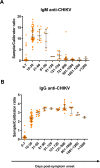Long-term persistence of serum IgM antibodies against chikungunya virus in patients with chronic arthralgia
- PMID: 40275382
- PMCID: PMC12020198
- DOI: 10.1186/s12985-025-02721-x
Long-term persistence of serum IgM antibodies against chikungunya virus in patients with chronic arthralgia
Erratum in
-
Correction: Long-term persistence of serum IgM antibodies against chikungunya virus in patients with chronic arthralgia.Virol J. 2025 Jun 3;22(1):179. doi: 10.1186/s12985-025-02812-9. Virol J. 2025. PMID: 40462167 Free PMC article. No abstract available.
Abstract
Background: Anti-Chikungunya virus (CHIKV) IgM antibodies may persist for months after infection in some individuals, but the evidence is limited, and their exact duration remains unknown.
Objective: This study aimed to determine the duration for which anti-CHIKV IgM antibodies remain detectable following acute infection.
Methods: A commercial ELISA was used to assess the frequency of anti-CHIKV IgM antibody detection over time in 145 longitudinal serum samples obtained from 45 laboratory-confirmed chikungunya patients in Brazil (two to six samples per patient).
Results: Among samples obtained within seven days post-symptom onset (DPSO), 13% (6/45) were IgM-positive. Between 10 and 120 DPSO, 100% (62/62) of samples were positive. Positivity rates for samples collected between 121 - 720, 721-900, 901-1,080, 1,081-1,260, and > 1,260 DPSO were 62% (5/8), 35% (6/17), 12% (1/8), 33% (1/3) and 50% (1/2), respectively. Notably, among 21 patients who developed chronic arthralgia and had at least one sample collected > 720 DPSO, 7 (33%) still had detectable anti-CHIKV IgM. This suggests that approximately one-third of chikungunya patients with chronic arthralgia may maintain anti-CHIKV IgM for over two years following acute disease.
Conclusions: Our findings indicate that anti-CHIKV IgM antibodies can persist substantially longer than typically observed for acute RNA virus infections. This has significant implications for chikungunya diagnosis and surveillance. Further research is needed to determine whether long-term IgM persistence also occurs in patients without chronic chikungunya symptoms.
Keywords: Chikungunya; Diagnosis; IgM antibody; Serology; Surveillance.
© 2025. The Author(s).
Conflict of interest statement
Declarations. Ethics approval and consent to participate: This study was approved by the Institutional Review Board of the Instituto Gonçalo Moniz, Fundação Oswaldo Cruz (CAAE: 55904616.4.0000.0040). Written informed consent was used during both enrollment in the surveillance study and the first consultation at the rheumatological clinic to explain the study’s aims, procedures, risks, and benefits. The forms were signed by participants ≥ 18 years old and parents of participants < 18. Minors (aged 5–17) also signed an informed assent form. Consent for publication: Not applicable. Competing interests: The authors declare no competing interests.
Figures


Similar articles
-
Chikungunya virus infection in Aruba: Diagnosis, clinical features and predictors of post-chikungunya chronic polyarthralgia.PLoS One. 2018 Apr 30;13(4):e0196630. doi: 10.1371/journal.pone.0196630. eCollection 2018. PLoS One. 2018. PMID: 29709007 Free PMC article.
-
Molecular and serological evidence of chikungunya virus among dengue suspected patients in Sri Lanka.J Infect Public Health. 2025 May;18(5):102709. doi: 10.1016/j.jiph.2025.102709. Epub 2025 Feb 19. J Infect Public Health. 2025. PMID: 40068344
-
Use of Household Cluster Investigations to Identify Factors Associated with Chikungunya Virus Infection and Frequency of Case Reporting in Puerto Rico.PLoS Negl Trop Dis. 2016 Oct 20;10(10):e0005075. doi: 10.1371/journal.pntd.0005075. eCollection 2016 Oct. PLoS Negl Trop Dis. 2016. PMID: 27764085 Free PMC article.
-
Diagnostic accuracy of serological tests for the diagnosis of Chikungunya virus infection: A systematic review and meta-analysis.PLoS Negl Trop Dis. 2022 Feb 4;16(2):e0010152. doi: 10.1371/journal.pntd.0010152. eCollection 2022 Feb. PLoS Negl Trop Dis. 2022. PMID: 35120141 Free PMC article.
-
Development of Vaccines for Chikungunya Fever.J Infect Dis. 2016 Dec 15;214(suppl 5):S488-S496. doi: 10.1093/infdis/jiw271. J Infect Dis. 2016. PMID: 27920179 Free PMC article. Review.
Cited by
-
Correction: Long-term persistence of serum IgM antibodies against chikungunya virus in patients with chronic arthralgia.Virol J. 2025 Jun 3;22(1):179. doi: 10.1186/s12985-025-02812-9. Virol J. 2025. PMID: 40462167 Free PMC article. No abstract available.
References
-
- Kang H, Auzenbergs M, Clapham H, Maure C, Kim JH, Salje H, et al. Chikungunya seroprevalence, force of infection, and prevalence of chronic disability after infection in endemic and epidemic settings: a systematic review, meta-analysis, and modelling study. Lancet Infect Dis. 2024;24:488–03. 10.1016/S1473-3099(23)00810-1. - PubMed
Publication types
MeSH terms
Substances
Grants and funding
- 440891/2016-7, 311365/2021-3 to G.S.R/Conselho Nacional de Desenvolvimento Científico e Tecnológico
- 440891/2016-7, 311365/2021-3 to G.S.R/Conselho Nacional de Desenvolvimento Científico e Tecnológico
- 440891/2016-7, 311365/2021-3 to G.S.R/Conselho Nacional de Desenvolvimento Científico e Tecnológico
- 440891/2016-7, 311365/2021-3 to G.S.R/Conselho Nacional de Desenvolvimento Científico e Tecnológico
- 440891/2016-7, 311365/2021-3 to G.S.R/Conselho Nacional de Desenvolvimento Científico e Tecnológico
LinkOut - more resources
Full Text Sources
Medical

